Ber Fruit: Indian Jujube Uses, Dose, Side Effect, Research
Ber fruit or Indian Jujube or Chinese apple is a Vitamin C rich fruit, used in Ayurveda for treating bleeding disorders, excessive thirst, fever, burning sensation etc. Its seeds possess anti cancer potential. Botanical names- Ziziphus mauritiana Lamk (Z. Jujuba Lamk)
Family- Rhamnaceae
This is the famous fruit which Shabari, an old lady served Lord Sri Ram in Ramayana. The old Lady was so full of devotion, while serving Sri Ram that she tasted every Jujube fruit before serving it to Lord Ram. The Lord, being compassionate towards his devotee accepted those fruits with much love.
Table of Contents
Vernacular names
Names in different languages:
Hindi name – Ber,
Telugu name- Regu chettu
Tamil name – Ilandai
English Name: Indian Jujube, ber, Chinee apple, jujube, Indian plum
Kannada name – Bore hannu, Bore mara
Sanskrit synonyms
Ajapriya, Karkandhu,
Kola – Seeds of badara are very hard
Badari
Sauveera – Commonly available in Sauverya desa
Gudaphala
Phenila – Badara fruit increases kapha
Karkandu – Tree conaiata thorns
Kuvala – Found in all over the world
Baleshta – liked by children
Morphology
Spiny, deciduous shrub or small tree
Leaves – Alternate, ovate to ovoid lanceolate, Serrate margins
Inflorescence – Axillary cyme
Fruit – Drupe, reddish brown when ripe, contain single stony seed
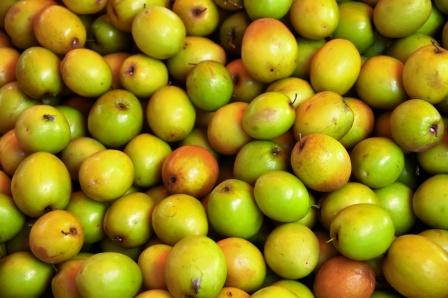
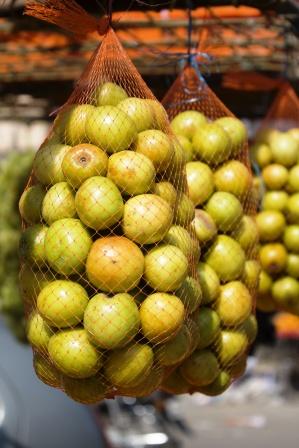
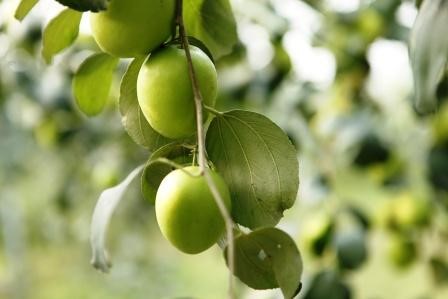
Chemical composition
Ziziphus mauritiana chemical composition:
Fruit: Rich in Vitamin C, Also contains Jujubosides A&B (seeds) , Zizogenin, Zeatin, Frangufoline, Saponin etc
Bark – Leucocyanidin, Mauritines A,B,C,D, E & F frangufoline.
Leaves- Rutin, Yuziphine, Yuzirin
Seeds: betulinic aldehyde, betulinic acid, ceanothic acid, frangufoline, spinosin, beta-sitosterol, daucosterol, daucosterol-6′-octadecanoate, sucrose, docosanoic acid, stearic acid, palmitoleic acid. (Reference)
Classical categorization
Badara – Classical categorisation:
Charaka –
Hrudya – Group of herb that acts as cardiac tonic, congenial for heart,
Svedopaga – Group Virechanopaga,
Chadri Nigrahana – Anti emetic group of herb
Phala Asava Yoni – Ber fruit is a source of fermented medicinal beverage (Reference: Charaka Sutrasthana 25)
Sushruta and Vagbhata –Nyagrodhadi gana
Sodala Nighantu, Raja Nighantu, Dhanvantari Nighantu, Bhavaprakasha – Amradi Varga
Kaiyadeva Nighantu – Oshadhi Varga
Kola – as a measuring unit:
Kola – the mid sized ber fruit weighs approximately 12 grams. It is used as a unit of measurement. The same unit is also called Aksha (size / weight of Vibhitaki – Baheda – Terminalia bellirica) fruit
Medicinal properties
Indian Jujube – Medicinal Properties:
Guna (qualities) – Guru (heaviness), Snigdha – unctuous, oily
Rasa (taste) – Madhura – sweet, Amla – sour taste
Veerya – Sheeta – Coolant
Effect on Tridosha :
Sweet ber fruit balances Vata and Pitta Dosha.
Sour fruit pacifies Vata and Kapha
Dried fruit pacifies Vata and Kapha Dosha but does not increase Pitta Dosha
Pharmacological actions
Aphrodisiac, Anodyne, Styptic, Stomachic, Expectorant
Laxative and tonic
Qualities as per Bhojana kutuhalam
Rasa (Taste) – Sweet, Astringent and sour
Virya (Potency) – Hot
Treats diarrhoea, fatigue, depletion of dhatus, pain and improves taste.
Aggravates kapha dosha.
Rajabadara
Taste – very sweet
Potency – Cold
Treats burning sensation, pain, Is aphrodisiac, increases virility and depletion of dhatus.
Bhubadari
Taste – Sweet and sour
Effects On Dosha – Treats vitiation of vata and kapha dosha
Imparts taste, is appetizing, promotes digestion, wholesome for the body but has small tendency to cause bleeding disorders.
Laghubadara
Taste – Sweet and sour
The ripened fruit is unctuous, improves taste perception, alleviates vata and kapha and treats burning sensation, depletion of dhatus, vitiation of pitta and minimally causes worm infestation.
The leaf of badara when made into a paste and used cures fever and burning sensation, the bark helps to cure eruptions and the seed cures ophthalmic diseases.
Types
Bhava Prakasha has mentioned about three varieties-
Sauveera – Bigger variety, also called Raja Badara – Ziziphus sativa
Kola – mid size fruits – Ziziphus jujuba, Ziziphus mauritiana
Karkandhu – small fruits
Ra. Ni – 3 types
Raja badara
Bhubadara
Laghu badara
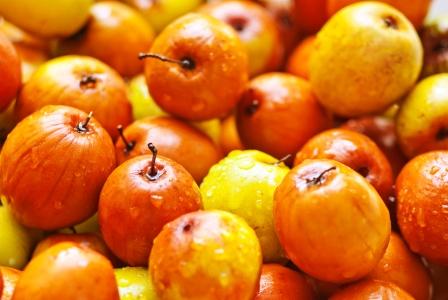
Part used, dosage
Part used- Root, leaf, Fruit
Dosage- Bark decoction 50-100 ml
Fruit – 5 – 10 numbers
How to consume:
Its fruits are consumed as it is. It is also made into pickles, beverages.
Its leaves or bark are made into decoction (Kashaya) – by adding water, boiling, filtered and used when hot.
The bark / leaf paste is made by drying them, grinding to fine powder, adding water and grinding again to make paste.
Sanskrit verse
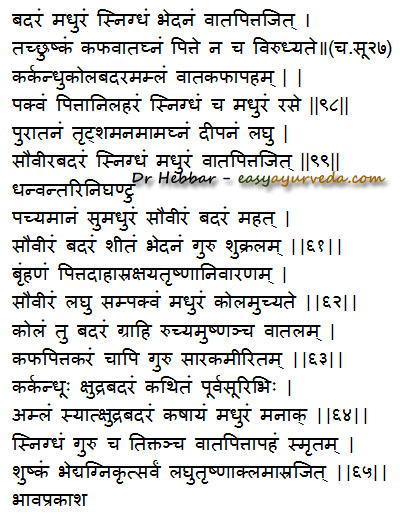
Ber fruit uses
Ripe Sweet ber fruit:
Snigdha – unctuous, oily
Bhedana – relieves constipation
Sour Jujube fruit Balances Vata and Kapha Dosha
Kola – Old or dried Chinese apple fruit: (Shushka Kola)
Balances Vata and Kapha Dosha, without increasing Pitta Dosha.
Trut shamana – relieves excessive thirst
Amaghna – Relieves ama – a product of indigestion and altered metabolism.
Deepana – improves digestion strength
Laghu – light to digest
Grahi – absorbent, useful in diarrhoea, IBS
Ruchya – improves taste, relieves anorexia
Sauveera Badara – Bigger variety, Rajabadara, also called Unnava – Ziziphus sativa
Botanical names- Zizyphus sativa Gaertn.(Z Vulgaris Lamk)
Family- Rhamnaceae
It is called Unnava / Unnav in Hindi.
Rajabadara qualities, indications
Snigdha – unctuous, oily
Madhura – sweet
Balances Vata and Pitta
Sheeta – Coolant
Guru – heavy to digest
Shukrala – improves sperm and semen quantity and quality
Bhedana – useful in constipation
Brumhana – nourishing, nutritious
Indicated in:
Pitta disorders
Daha – burning sensation, as in gastritis, neuropathy, burning sensation in eyes etc
Asra – blood disorders such as abscess, skin disorders, bleeding disorders such as menorrhagia, nasal bleeding etc.
Kshaya – depletion of body tissues, weight loss, tuberculosis
Trushna – excessive thirst
Kshudrabadara qualities
Kshudrabadara – Karkandhu – smaller variety:
Kashaya – Astringent
Madhura – sweet
Snigdha – unctuous, oily
Guru – heavy to digest
Tikta – bitter
Balances Vata and Pitta
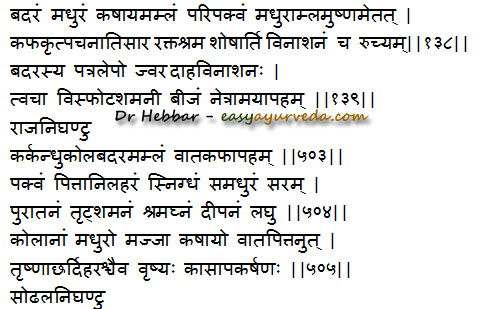
Uses of other parts
Uses of other tree parts of ber fruit / Indian Jujube:
Patralepa – Paste made out of leaves of Indian Jujube is applied externally to relieve burning sensation and fever. It helps to bring down body temperature.
Bark of Indian Jujube tree is made to paste and applied externally to treat Visphota – Boils, abscess
The seeds of ber fruit are useful in Netramaya – eye disorders
The decoction of bark of Jujube is used as co drink (Anupana) along with Narayana churna to treat bloating and abdominal distension.
Ayurvedic medicines
Ayurvedic medicines with Badara as ingredient:
Ajamamsa Rasayan – used in treatment of Vata disorders like loss of strength, hemiplegia etc.
Panchamla Thailam – Leaves of Jujube tree is used as an ingredient in this oil. This is used for the treatment of rheumatoid arthritis and ascites.
Research
Anticancer potential of seed extract of Z. mauritiana – Treatment of Ehrlich ascites carcinoma bearing Swiss albino mice with varied doses (100–800 mg/kg b.wt.) of plant extract significantly reduced tumour volume and viable tumour cell count and improved haemoglobin content, RBC count, mean survival time, tumour inhibition, and percentage life span. The enhanced antioxidant status in extract-treated animals was evident from decline in levels of lipid per-oxidation and increased levels of glutathione, catalase, and superoxide dismutase.
Antibacterial activity of Ziziphus mauritiana Lam. and Ziziphus xylopyra (Retz.) Willd.
Side effects, incompatibility
There are no known side effects with Ber fruit and its tree parts. Its fruits are commonly consumed during pregnancy, lactating mothers and by children.
Incompatibility:
Sour Jujube fruit is incompatible with milk (reference: )
Interaction with medicines, supplements
Can this be used while taking Homeopathic medicine?
Yes. This product does not react with homeopathic medicine.
Can
this medicine be continued while taking supplements like multivitamin tablets,
Omega 3 fatty acids etc?
Yes. Generally, this product goes well with most
of the dietary supplements. However, if you are taking more than one product
per day, please consult your doctor for an opinion.
With western
medicines
Seek your
doctor’s advice if you are taking this product along with other western
(allopathic / modern) medicines. Some Ayurvedic herbs can interact with modern
medicine.
If both Ayurvedic and allopathic medicines are advised together, then it is
best to take Allopathic medicine first, wait for 30 minutes and then take the
Ayurvedic medicine.
Other uses
Use of Badara in Panchakarma treatment:
Ber is used in Sweating and Virechana treatment (purgation).
In Snehana treatment, for treating male and female reproductive system disorders, such as infertility, heavy periods, low sperm quality / quantity etc, The Shena (fat) is prepared with sesame oil, marrow, muscle fat, ghee and the decoction of Badara – Zizyphus jujuba, Triphala. (reference: Charaka Sutrasthana 13/95
Ber fruit for gastritis:
If it is sour, then not good for gastritis, sweet and ripe fruits are very good to calm stomach and to relieve gastritis.
Ber decoction sitz bath for hemorrhoids:
To the pile mass, sesame oil is applied. A decoction of ber is prepared. The decoction should be lukewarm. The patient is made to take sitz bath in the decoction for 5 – 10 minutes. It reduces pain, itching and size of the pile mass. (Charaka Samhita Chikitsa Sthana 14th chapter).
Badara leaves for laryingitis and cough:
Paste of Badari leaves are fried in ghee and given mixed with rock salt to alleviate laryngitis associated with cough.











11 comments
Sai
Great fruit ….We have all ahad this when we were kids…..While the sweet fruit is good for gastritis. does it have any efect on acidity …..Pls advice
Dr J V Hebbar MD(Ayu)Author
It even is available nowadays in the market, in the plastic package, like the image that I have put in the article. 🙂
If it is sour, then not good for gastritis, sweet and ripe fruits are very good to calm stomach and to relieve gastritis.
vishweshwar kokate
ber is seasona l fruit , is there any other similar fruit or ber churna which ca be taken throught the year.
Dr J V Hebbar MD(Ayu)Author
Amla.
SHRIGANESH S. DEVARKONDA
Great fruit, with sweet taste & lot’s uses.
Sir, can we use essential oils for good health & how?
Dr J V Hebbar MD(Ayu)Author
Read here – http://www.edensgarden.com/pages/home
a.a.pandiyan
IS THERE ANY fermentation method with BER FRUIT, as mentioned some where in here, such as wine, that we can use longer time since it is a seasonal fruit? kindly give the method for good medicinal value, that can be prepared at home.
Dr J V Hebbar MD(Ayu)Author
Hi, ber fruit is fermented with jaggery and spices such as cardamom and black pepper, for a period of 1 month and used.
Dona
Does it cause cough?
Dr J V Hebbar MD(Ayu)Author
No.
Ravikantha
It’s really helpful for me, thanks sir.